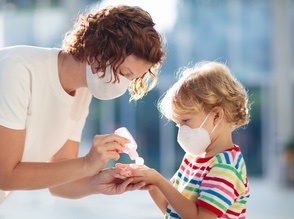Recently, the Delta variation of COVID-19 caused a 240 percent surge in pediatric infections. The number of children under four years old, and not yet covered by states’ vaccination efforts, who were hospitalized because of COVID-19 increased 10-fold.
These developments prompted the American Medical Association (AMA) to offer parents some guidance about how to protect children from COVID-19 infections, particularly as children return to in-person learning around the country.
Masks are the single best way parents can keep kids from getting sick, so the AMA recently published a Patient Page to encourage parents of young children to do everything they can to reduce their own and their children’s risk of coming down with COVID-19.The group advises that all children two and older should wear a mask when indoors. Children under two are too small to use masks safely.
Children under two are too small to use masks safely. Their small airways make it harder to breathe, and they are less able to communicate breathing difficulties to parents. They are also less likely to keep the mask on.
Fit is important and can be tricky, especially for smaller children who cannot fit into adult-sized masks. Neck gaiters, scarves tied around the mouth, or any masks with valves are not recommended.
The AMA urges parents to discard surgical masks after six hours of use or if they become wet or damaged. Cloth masks should be hand or machine washed after every use with warm water and laundry detergent.The number of children under four years old who were hospitalized because of COVID-19 has increased 10-fold.
There’s a lot for kids to know: Children need to be clear on why it is important to wash their hands often, to use hand sanitizer, and to avoid touching their nose, eyes and mouth. They should know to wash or sanitize their hands before wearing or removing masks and before eating. When in public or at school, a child should be clear that they should only take off their mask when eating or drinking and know to stay at least 6 feet away from their classmates when they are not wearing a mask.
Younger children may not remember a time before the COVID-19 pandemic. Older children, however, may be growing impatient with daily masking. Both groups will take cues from their parents, so parents should model the routine they want their kids to use. The AMA suggests parents always wear a mask in public and in that way affirm its routine use.
You may need to get creative to convince your child of the importance of wearing a mask. The Patient Page suggests parents use an umbrella as an example of a form of protection young kids can understand. A parent might tell their young son or daughter, “You use an umbrella to protect yourself when it is raining, so you can still play with your friends and be outside in bad weather. A mask does the same thing — it protects you from the virus so you can still go out and play.”
The Patient Page is published in JAMA Pediatrics and can be downloaded here.





